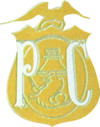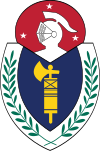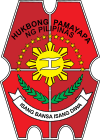Chief of the Philippine Constabulary
This article includes a list of general references, but it lacks sufficient corresponding inline citations. (November 2023) |
| Chief of the Philippine Constabulary | |
|---|---|
| Puno ng Hukbóng Pamayapà ng Pilipinas Jefe de la Constabularía Filipina | |
   | |
| Department of National Defense (1938) Armed Forces of the Philippines (1935) | |
| Abbreviation | CPC |
| Reports to | Governor-General (1901–1935) President of the Philippine Commonwealth (1935–1942; 1945–1946) President (thru Secretary of Defense) (1946–1990) |
| Residence | Camp Crame, Quezon City |
| Appointer | Governor-General (until 1934) President (from 1934)
|
| Term length | 3 years unless remove or promoted to higher AFP position |
| Formation | 1901 |
| First holder | Captain Henry T. Allen, USA |
| Final holder | Major General Ramon Montaño, PC/INP |
| Succession | Chief of the Philippine National Police (PNP) |
| Deputy | Deputy Chief of Philippine Constabulary |
The Chief of the Philippine Constabulary (Filipino: Puno ng Hukbóng Pamayapà ng Pilipinas; Spanish: Jefe de la Constabularía Filipina) was the head of the Philippine Constabulary, the former gendarmerie-type military police force of the Philippines from 1901 to 1991 and the predecessor to the modern-day Philippine National Police. It was founded in 1901 by Captain Henry T. Allen and considered as the founder.[1] The position is invariably held by a PC Brigadier General until 1976 where in it was held by a Major General. Lieutenant General can be attained if the PC officer was appointed as Vice Chief of Staff, AFP or General if the PC officer is appointed to Chief of Staff, AFP.
In some occasions several Army and Air Force General officers was appointed as Chief of Constabulary, where they go back to their original branch of service after his term.
Tenure[edit]
A Colonel or Brigadier General can be appointed as Chief of Constabulary by the Governor-General but in 1935 President of the Philippine Commonwealth/Republic of the Philippines. In the initial years there was no limit for the position but in 1935 Philippine Government started to imposed term limit to 3 years but unless appointed to higher position in the Armed Forces such Deputy Chief of Staff, AFP, Vice Chief of Staff, AFP or Chief of Staff, AFP he has 3 years to in the office unless relieved by the President.
Duties and responsibilities[edit]
The Chief of Constabulary shall be directly responsible to the President for the execution of all police duties, responsibilities and functions heretofore pertaining to the Philippine Constabulary and those specifically assigned to him by the President. Subject to the approval of the President he will prescribe and issue regulations for the conduct and administration of the Constabulary. He will administer all laws and regulations affecting personnel of the Constabulary, excepting those pertaining to the procurement of military personnel and the promotion of officers. For purposes of record, he will transmit to the Adjutant General of the Philippine Army such reports and returns as may be necessary to enable that office to maintain permanent records of all personnel. Annual eligibility and efficiency boards appointed in the Army under the orders of the President will include proportionate representation from the Constabulary.[2]
Residence and headquarters[edit]
Old Gagalangin Barracks[edit]
Is the first headquarters of PC and where the Chief of Constabulary held his office. It was its official home from 1901 to 1935. Until new Camp was constructed by PC in a new track of land given by City of Manila in exchange for the Old Barracks.
Camp Crame[edit]
Since 1935, then Constabulary Chief Brigadier General Basilio Valdes constructed building around the track of land New Manila Heights in Quezon City provided by City of Manila in exchange for the Old Barracks. He named the camp after the first Filipino Constabulary Chief Brigadier General Rafael Crame. It has been the official headquarters of PC since 1935 to 1991. Now it is the official headquarters of Philippine National Police the successor of PC/INP since it was deactivated in 1991.
Headquarters organization[edit]
Headquarters Directorates:
- 1. Directorate for Personnel
- 2. Directorate for Human Resource and Doctrine Development
- 3. Directorate for Logistics,
- 4. Directorate for Research and Development
- 5. Directorate for Comptrollership,
- 6. Directorate for Plans,
- 7. Directorate for Police-Community Relations,
- 8. Directorate for Investigation and
- 9. Directorate for Special Staff
List[edit]
The following lists people who have assumed the position of Chief of the Philippine Constabulary since its creation to its deactivation. This includes people who served as Officer in Charge (OIC) of the PC. This excludes OIC tenure due to temporary incapacitation of filing of a leave of absence of the incumbent – who would later resume fulfilling their duties.
| No. | Name | Citizenship | Term | Notes | Ref[3] |
|---|---|---|---|---|---|
| Commander of Philippine Constabulary | |||||
| 1 | Capt./Brig. GeneralHenry T. Allen | June 1901 – August 1907 | Founding Commander, served in France during World War I. Commanded 90th US Infantry Division. | [1][3] | |
| 2 | Col. Harry Hill Bandholtz | August 1907 – 1910 | He served as assistant Chief from 1903 - 1909. He was acting chief while General Allen was in US. He would resumed as Assistant Chief under General Smith 1910 - 1913. | [3] | |
| 3 | Col. Cornelius C. Smith | 1910–1912 | [3] | ||
| 4 | Brig. Gen. James G. Harbord | 1913 | [3] | ||
| 5 | Brig. Gen. William C. Rivers | 1914 | |||
| 6 | Brig. Gen. Herman Hall | 19114–1917 | |||
| 7 | Brig. Gen. Rafael Crame | 1917–1927 | First Filipino Commander (1917–1927); | ||
| 8 | Brig. Gen. Carl Nathorst | 1927–1932 | Swedish Soldier who enlisted in US Army and deployed in the Philippines in 1899 with Minnesota Volunteers. He was appointed in the Constabulary until promoted to Brigadier General as head of the organization. | ||
| 9 | Brig. Gen. Lucien R. Sweet | 1932 | |||
| 10 | Brig. Gen. Clarence H. Bowers | 1932–1934 | |||
| 11 | Brig. Gen. Basilio J. Valdes | 1934–1935 | from 1934 | ||
| 12 | Maj. Gen. Jose Delos Reyes | 1935–1938 | He served an Army Provost Marshal General after serving acting Chief of Staff in 1936, he also was the con-current commander of Constabulary Division, PA while being a Provost Marshal General. | ||
| 13 | Brig. Gen. Guillermo Francisco | 1938–1942 | 1938 – 1941; resumed under Japanese Occupation until 1945 | [4] | |
| Bureau of Constabulary (Japanese Occupation) | |||||
| 14 | Brig. Gen. Jose Delos Reyes | November 1942 – April 1943 | Appointed by Japanese Occupiers as Director for Bureau of Constabulary. Former acting Army Chief of Staff. | ||
| 15 | Brig. Gen. Guillermo Francisco | April 1943 – October 1944 | Appointed by President Laurel as Director for Bureau of Constabulary | ||
| 16 | Maj. Gen. Paulino Santos | October 1944 – 1945 | Recalled by President Laurel from retirement to be the head of Bureau of Constabulary, however was captured by Japanese for helping people and guerillas after assuming the position. He died in Kianga, Ifugao as he was not allowed by Japanese captors to go American hospital for treatment. | ||
| Liberation to Martial Law Years | |||||
| 17 | Brig. Gen. Federico G. Oboza | 1945–1946 | |||
| 18 | Brig. Gen. Mariano Castañeda | 1946–1948 | Became Chief of Staff and Medal of Valor Awardee | ||
| 19 | Brig. Gen. Alberto Ramos | 1948–1950 | Relieved by President Quirino upon the recommendation of Defense Secretary Magsaysay. He was appointed Presidential Adviser on Police Affairs and later Director of National Bureau of Investigation. | ||
| 20 | Brig. Gen. Florencio Selga | 1950–1955 | |||
| 21 | Brig. Gen. Manuel Cabal | 1955–1957 | Became Chief of Staff in 1959 | ||
| 22 | Brig. Gen. Pelagio A. Cruz | 1958–1958 | Returned to PAF after his term and appointed as Chief of Staff in 1961 | [5] | |
| 23 | Brig. Gen. Isagani Villoria Campo | 1958–1961 | |||
| 24 | Brig. Gen. Nicanor Garcia | 1961–1963 | |||
| 25 | Brig. Gen. Dominador Garcia | 1963 | |||
| 26 | Brig. Gen. Godofredo F. Mendoza | 1964 | |||
| 27 | Brig. Gen. Vicente M. Yngente | 1964 | |||
| 28 | Brig. Gen. Flaviano Olivares | 1965–1966 | |||
| 29 | Brig. Gen. Segundo P. Velasco | 1966–1967 | Became AFP Chief of Staff in 1967 | ||
| 30 | Brig. Gen. Manuel Yan | 1967–1968 | Became youngest AFP Chief of Staff in 1968 | ||
| 31 | Brig. Gen. Vicente Raval | 1968–1970 | |||
| 32 | Brig. Gen. Eduardo Garcia | 1970–1972 | |||
| Chief of Philippine Constabulary/Director General of Integrated National Police | |||||
| 33 | Lt. Gen. Fidel Valdez Ramos | 1972–1986 | Served as acting AFP Chief of Staff from 1984 to 1985 and Vice AFP Chief of Staff while concurrent PC Chief in 1984 to 1986 before EDSA Revolution. He became AFP Chief of Staff in 1986 after EDSA Revolution, later Defense Secretary and President of the Philippines from 1992 to 1998. | [6] | |
| 34 | Lt. Gen. Renato de Villa | 1986–1988 | was concurrent Vice Chief of Staff of AFP while in the position. He was appointed as AFP Chief of Staff in 1988 to 1991. | ||
| 35 | Maj. Gen. Ramon Montaño | 1988 – 1990 | Former CAPCOM commander | ||
| 36 | Maj. Gen. Cesar P. Nazareno | 1990 – March 1991 | Last chief before disbandment | [7] | |
See also[edit]
- Armed Forces of the Philippines
- Philippine National Police
- Chief of Philippine National Police
- Chief of Staff of the Armed Forces of the Philippines
- Vice Chief of Staff of the Armed Forces of the Philippines
- Deputy Chief of Staff of the Armed Forces of the Philippines
References[edit]
- ^ a b www.coursehero.com https://www.coursehero.com/file/122304160/MODULE4-LEA101-1docx/. Retrieved 2023-11-27.
{{cite web}}: Missing or empty|title=(help) - ^ https://www.officialgazette.gov.ph/1938/06/23/executive-order-no-153-s-1938/
 This article incorporates text from this source, which is in the public domain.
This article incorporates text from this source, which is in the public domain.
- ^ a b c d e https://www.armyupress.army.mil/Portals/7/military-review/Archives/English/SO-21/cross-philippine/cross.pdf
- ^ "Quezon appoints Francisco as PC Chief". October 21, 1938.
- ^ https://www.officialgazette.gov.ph/1962/01/08/official-week-in-review-december-31-january-6-1962/
- ^ Gavilan, Jodesz. "Marcos and his men: Who were the key Martial Law figures?". Retrieved August 21, 2020.
- ^ "POLICE REGIONAL OFFICE 3".
